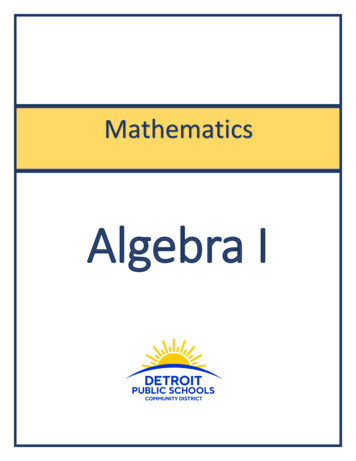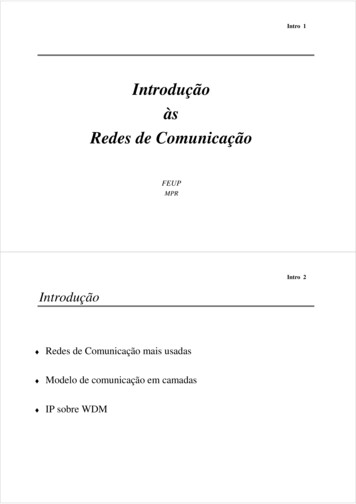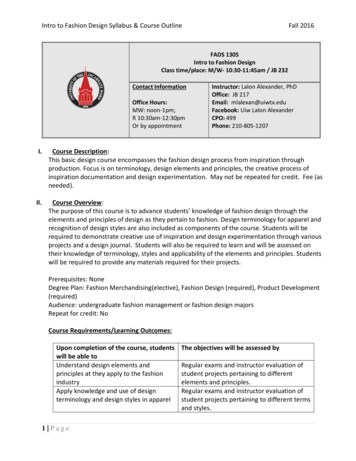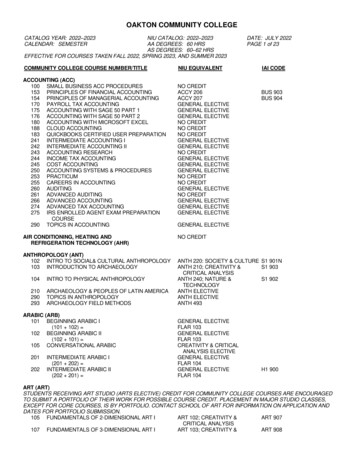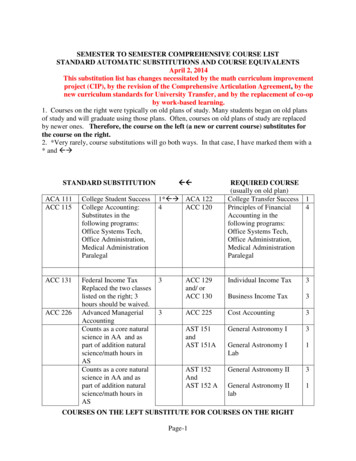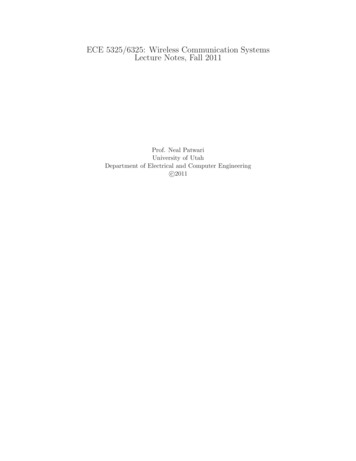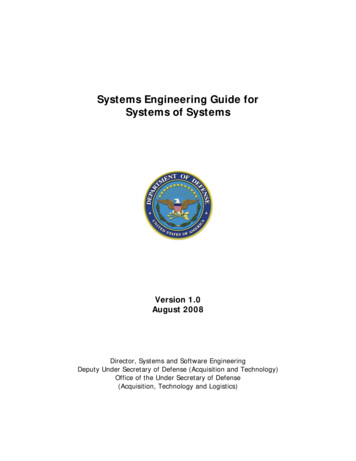
Transcription
CS 31: Intro to SystemsISAs and AssemblyKevin WebbSwarthmore CollegeSeptember 25, 2018
Overview How to directly interact with hardware Instruction set architecture (ISA)– Interface between programmer and CPU– Established instruction format (assembly lang) Assembly programming (IA-32)
AbstractionUser / ProgrammerWants low complexityApplicationsSpecific functionalitySoftware libraryReusable functionalityOperating systemManage resourcesComplex devicesCompute & I/O
AbstractionApplicationsSpecific functionalityThis week: Machine InterfaceOperating systemManage resourcesComplex devicesLastCompute & I/Oweek: Circuits, Hardware Implementation
Compilation Steps (.c to a.out)textC program (p1.c)Usually compile to a.out ina single step: gcc –m32 p1.c-m32 tells gcc to compile for32-bit Intel machinesCompiler (gcc –m32)Reality is more complex:there are intermediate steps!executablebinaryExecutable code (a.out)
Compilation Steps (.c to a.out)textCS75C program (p1.c)Compiler (gcc –m32 -S)textexecutablebinaryAssembly program (p1.s)Executable code (a.out)You can see the results ofintermediate compilationsteps using different gcc flags
Assembly CodeHuman-readable form of CPU instructions– Almost a 1-to-1 mapping to Machine Code– Hides some details: Registers have names rather than numbers Instructions have names rather than variable-size codesWe’re going to use IA32 (x86) assembly– CS lab machines are 64 bit version of this ISA, butthey can also run the 32-bit version (IA32)– Can compile C to IA32 assembly on our system:gcc –m32 -S code.c # open code.s in editor to view
Compilation Steps (.c to a.out)textC program (p1.c)Compiler (gcc –m32 -S)textYou can see the results ofintermediate compilationsteps using different gcc flagsAssembly program (p1.s)Assembler (gcc -c (or as))binaryObject code (p1.o)Linker (gcc (or ld))executablebinaryExecutable code (a.out)Other object files(p2.o, p3.o, )Library obj. code(libc.a)
Object / Executable / Machine CodeAssemblypush %ebpmov %esp, %ebpsub 16, %espmovl 10, -8(%ebp)movl 20, -4(%ebp)movl -4(%ebp), eaxaddl eax, -8(%ebp)movl -8(%ebp), %eaxleaveMachine Code (Hexadecimal)5589 E583 EC 10C7 45 F8 0A 00 00 00C7 45 FC 14 00 00 008B 45 FC01 45 F8B8 45 F8C9
Object / Executable / Machine CodeAssemblypush %ebpmov %esp, %ebpsub 16, %espmovl 10, -8(%ebp)movl 20, -4(%ebp)movl -4(%ebp), eaxaddl eax, -8(%ebp)movl -8(%ebp), %eaxleaveMachine Code (Hexadecimal)55int main() {89 E5 int a 10;83 EC 10int b 20;C7 45 F8 0A 00 00 00C7 45 FC 14 00 00 00 a b;8B 45 aFC01 45 F8B8 45 returnF8a;C9}
Compilation Steps (.c to a.out)textC program (p1.c)High-level languageCompiler (gcc –m32 -S)Interface for speaking to CPUtextAssembly program (p1.s)Assembler (gcc -c (or as))binaryObject code (p1.o)Linker (gcc (or ld))executablebinaryExecutable code (a.out)CPU-specific format (011010 )Other object files(p2.o, p3.o, )Library obj. code(libc.a)
Instruction Set Architecture (ISA) ISA (or simply architecture):Interface between lowest software level andthe hardware. Defines specification of the language forcontrolling CPU state:– Provides a set of instructions– Makes CPU registers available– Allows access to main memory– Exports control flow (change what executes next)
Instruction Set Architecture (ISA) The agreed-upon interface between allsoftware that runs on the machine and thehardware that executes it.Application / ProgramCompilerOperatingSystemCPU / Processor I/O systemDigital CircuitsLogic GatesInstruction SetArchitecture
ISA Examples Intel IA-32 (80x86)ARMMIPSPowerPCIBM CellMotorola 68k Intel IA-64 (Itanium)VAXSPARCAlphaIBM 360
How many of these ISAs have youused? (Don’t worry if you’re not sure. Try to guessbased on the types of CPUs/devices you interact with.) Intel IA-32 (80x86)ARMMIPSPowerPCIBM CellMotorola 68k A. 0B. 1-2C. 3-4D. 5-6E. 7 Intel IA-64 (Itanium)VAXSPARCAlphaIBM 360
ISA CharacteristicsHigh-level languageISAHardware Implementation Above ISA: High-level language (C, Python, )– Hides ISA from users– Allows a program to run on any machine(after translation by human and/or compiler) Below ISA: Hardware implementing ISA canchange (faster, smaller, )– ISA is like a CPU “family”
ISA CharacteristicsHigh-level languageISAHardware Implementation Above ISA: High-level language (C, Python, )– Hides ISA from users– Allows a program to run on any machine(after translation by human and/or compiler) Below ISA: Hardware implementing ISA canchange (faster, smaller, )– ISA is like a CPU “family”
Instruction Translationsum.c (High-level C)int sum(int x, int y){int res;res x y;return res;}sum.s from sum.c:gcc –m32 –S sum.csum.s p%esp,%ebp 24, %esp12(%ebp),%eax8(%ebp),%eax%eax, -12(%ebp)Instructions to set up the stackframe and get argument valuesAn add instruction to compute sumInstructions to return from function
ISA Design Questionssum.c (High-level C)int sum(int x, int y){int res;res x y;return res;}sum.s from sum.c:gcc –m32 –S sum.csum.s p%esp,%ebp 24, %esp12(%ebp),%eax8(%ebp),%eax%eax, -12(%ebp)What should these instructions do?What is/isn’t allowed by hardware?How complex should they be?Example: supporting multiplication.
C statement: A A*BSimple instructions:Powerful instructions:LOAD A, eaxLOAD B, ebxPROD eax, ebxSTORE ebx, AMULT B, ATranslation:Load the values ‘A’ and ‘B’ from memory into registers, computethe product, store the result in memory where ‘A’ was.
Which would you use if you weredesigning an ISA for your CPU? (Why?)Simple instructions:Powerful instructions:LOAD A, eaxLOAD B, ebxPROD eax, ebxSTORE ebx, AMULT B, AA. SimpleB. PowerfulC. Something else
RISC versus CISC (Historically) Complex Instruction Set Computing (CISC)––––Large, rich instruction setMore complicated instructions built into hardwareMultiple clock cycles per instructionEasier for humans to reason about Reduced Instruction Set Computing (RISC)––––Small, highly optimized set of instructionsMemory accesses are specific instructionsOne instruction per clock cycleCompiler: more work, more potential optimization
So . . . Which System “Won”? Most ISAs (after mid/late 1980’s) are RISC The ubiquitous Intel x86 is CISC– Tablets and smartphones (ARM) taking over? x86 breaks down CISC assembly into multiple,RISC-like, machine language instructions Distinction between RISC and CISC is less clear– Some RISC instruction sets have more instructionsthan some CISC sets
ISA Examples Intel IA-32 (CISC)ARM (RISC)MIPS (RISC)PowerPC (RISC)IBM Cell (RISC)Motorola 68k (CISC) Intel IA-64 (Neither)VAX (CISC)SPARC (RISC)Alpha (RISC)IBM 360 (CISC)
ISA CharacteristicsHigh-level languageISAHardware Implementation Above ISA: High-level language (C, Python, )– Hides ISA from users– Allows a program to run on any machine(after translation by human and/or compiler) Below ISA: Hardware implementing ISA canchange (faster, smaller, )– ISA is like a CPU “family”
Intel x86 Family (IA-32)Intel i386 (1985) 12 MHz - 40 MHz 300,000 transistors Component size: 1.5 µmIntel Core i9 9900k (2018) 4,000 MHz 7,000,000,000 transistors Component size: 14 nmEverything in this family uses the same ISA (Same instructions)!
Processor State in Registers Information aboutcurrently executingprogram Temporary data( %eax - %edi ) Location of runtime stack( %ebp, %esp ) Location of current codecontrol point ( %eip, ) Status of recent tests%EFLAGS( CF, ZF, SF, OF )%eax%ecx%edxGeneral purposeregisters%ebx%esi%edi%esp%ebpCurrent stack top%eipProgram Counter (PC)CFZFCurrent stack frameSFOF Condition codes
Assembly Programmer’s View of State32-bit 00000Addresses%edx0x00000001%ebx p%ebp%eipnext instraddr (PC)%EFLAGScond. codesRegisters:PC: Program counter (%eip)Condition codes (%EFLAGS)General Purpose (%eax - %ebp)value0xffffffffMemory: Byte addressable array Program code and data Execution stack
General purpose Registers Remaining Six are for instruction operands– Can store 4 byte data or address value (ex. 3 5)RegisternameRegistervalue%eax3%ecx5%edx8The low-order 2 bytes and two low-order 1 bytesof some of these can be named (see fig 3.2)%ax is the low-order 16 bits of %eax%al is the low-order 8 bits of %eaxMay see their use in ops involving shorts or charsbits: %ebx%esi%edi%esp%ebp
General purpose Registers Remaining Six are for instruction operands– Can store 4 byte data or address value (ex. 3 %edi%esp%ebp%eip%EFLAGSTakeaway: the instructions in IA32 assembly willrefer to these register names when selectingALU operands and locations to store results.
Types of IA32 Instructions Data movement– Move values between registers and memory– Example: movl Load: move data from memory to register Store: move data from register to memory
Data MovementMove values between memory and registers or between two registers.Program Counter (PC):(Memory)Memory address of next instr0:1:Instruction Register (IR):Instruction contents (bits)2:3:4: Data inWEData inWEData inWEData inWEN-1:32-bit Register #0MUX32-bit Register #132-bit Register #2MUX32-bit Register #3 Register FileALU
Types of IA32 Instructions Data movement– Move values between registers and memory Arithmetic– Uses ALU to compute a value– Example: addl
ArithmeticUse ALU to compute a value, store result in register / memory.Program Counter (PC):(Memory)Memory address of next instr0:1:Instruction Register (IR):Instruction contents (bits)2:3:4: Data inWEData inWEData inWEData inWEN-1:32-bit Register #0MUX32-bit Register #132-bit Register #2MUX32-bit Register #3 Register FileALU
Types of IA32 Instructions Data movement– Move values between registers and memory Arithmetic– Uses ALU to compute a value Control– Change PC based on ALU condition code state– Example: jmp
ControlChange PC based on ALU condition code state.Program Counter (PC):(Memory)Memory address of next instr0:1:Instruction Register (IR):Instruction contents (bits)2:3:4: Data inWEData inWEData inWEData inWEN-1:32-bit Register #0MUX32-bit Register #132-bit Register #2MUX32-bit Register #3 Register FileALU
Types of IA32 Instructions Data movement– Move values between registers and memory Arithmetic– Uses ALU to compute a value Control– Change PC based on ALU condition code state Stack / Function call (We’ll cover these in detail later)– Shortcut instructions for common operations
Addressing Modes Data movement and arithmetic instructions:– Must tell CPU where to find operands, store result You can refer to a register by using %:– %eax addl %ecx, %eax– Add the contents of registers ecx and eax, storeresult in register eax.
Addressing Mode: Immediate Refers to a constant value, starts with movl 10, %eax– Put the constant value 10 in register eax.
Addressing Mode: Memory Accessing memory requires you to specifywhich address you want.– Put address in a register.– Access with () around register name. movl (%ecx), %eax– Use the address in register ecx to access memory,store result in register eax
Addressing Mode: Memory movl (%ecx), %eax– Use the address in register ecx to access memory,store result in register eaxCPU Registersnamevalue%eax0%ecx0x1A68 (Memory)0x0:0x4:0x8:0xC: 0x1A640x1A680x1A6C0x1A70 0xFFFFFFFF:42
Addressing Mode: Memory movl (%ecx), %eax– Use the address in register ecx to access memory,store result in register eaxCPU x8:0xC: 0x1A64 0x1A681. Index into memory using theaddress in ecx.0x1A6C0x1A70 0xFFFFFFFF:42
Addressing Mode: Memory movl (%ecx), %eax– Use the address in register ecx to access memory,store result in register eaxCPU Registersnamevalue%eax42%ecx0x1A682. Copy value at thataddress to eax.(Memory)0x0:0x4:0x8:0xC: 0x1A64 0x1A681. Index into memory using theaddress in ecx.0x1A6C0x1A70 0xFFFFFFFF:42
Addressing Mode: Displacement Like memory mode, but with constant offset– Offset is often negative, relative to %ebp movl -12(%ebp), %eax– Take the address in ebp, subtract twelve from it,index into memory and store the result in eax
Addressing Mode: Displacement movl -12(%ebp), %eax– Take the address in ebp, subtract twelve from it,index into memory and store the result in eax(Memory)CPU Registersnamevalue%eax0%ecx0x1A68%ebp0x1A70 0x0:0x4:0x8:0xC: 1. Access address:0x1A70 – 12 0x1A640x1A64110x1A68420x1A6C0x1A70 0xFFFFFFFF:
Addressing Mode: Displacement movl -12(%ebp), %eax– Take the address in ebp, subtract three from it,index into memory and store the result in eaxCPU Registersnamevalue%eax11%ecx0x1A68%ebp0x1A70 2. Copy value at thataddress to eax.(Memory)0x0:0x4:0x8:0xC: 1. Access address:0x1A70 – 12 0x1A640x1A64110x1A68420x1A6C0x1A70 0xFFFFFFFF:Not this!
Let’s try a few examples.
What will memory look like after these instructions?x is 2 at %ebp-8,y is 3 at %ebp-12,movl -16(%ebp),%eaxsall 3, %eaximull 3, %eaxmovl -12(%ebp), %edxaddl -8(%ebp), %edxaddl %edx, %eaxmovl %eax, 2643%eax?0x12682%edx?0x126cname%ebp0x12700x1270 z is 2 at %ebp-16
What will memory look like after these instructions?x is 2 at %ebp-8,y is 3 at %ebp-12,movl -16(%ebp),%eaxsall 3, %eaximull 3, %eaxmovl -12(%ebp), %edxaddl -8(%ebp), %edxaddl %edx, %eaxmovl %eax, ssD:value0x126020x126430x1268530x126c0x1270 addressB:z is 2 at 00x1270
Solutionx is 2 at %ebp-8, y is 3 at %ebp-12, z is 2 at %ebp-16movlsallimullmovladdladdlmovl-16(%ebp), %eax 3, %eax 3, %eax-12(%ebp), %edx-8(%ebp), %edx%edx, %eax%eax, -8(%ebp)Equivalent C code:x z*24 y 0x126c0x1270
Solutionx is 2 at %ebp-8, y is 3 at %ebp-12, z is 2 at %ebp-16movlsallimullmovladdladdlmovl-16(%ebp), %eax 3, %eax 3, %eax-12(%ebp), %edx-8(%ebp), %edx%edx, %eax%eax, -8(%ebp)Equivalent C code:x z*24 y x;#######R[%eax] zR[%eax] z 3R[%eax] 16*3R[%edx] yR[%edx] y xR[%eax] 48 5M[R[%ebp] 8] 5(2)(16) Z*24(48)(3)(5)(53)(x 12700x126c0x1270
What will the machine state be afterexecuting these instructions?movlsublmovlorlneglmovl%ebp, %ecx 16, %ecx(%ecx), %eax%eax, -8(%ebp)%eax%eax, 5%ecx?0x45683name%ebp0x456C0x456C
How would you do this in IA32?x is 2 at %ebp-8, y is 3 at %ebp-12, z is 2 at ue0x12700x126c0x1270C code: z x y
How would you do this in IA32?x is 2 at %ebp-8, y is 3 at %ebp-12, z is 2 at ue0x12700x126c0x1270C code: z x ymovlA: movlxorlmovl-8(%ebp), %eax-12(%ebp), %edx%eax, %edx%eax, -16(%ebp)movlC: movlxorlmovl-8(%ebp), %eax-12(%ebp), %edx%eax, %edx%eax, -8(%ebp)movlB: movlxorlmovl-8(%ebp), %eax-12(%ebp), %edx%edx, %eax%eax, -16(%ebp)movlD: movlxorlmovl-16(%ebp), %eax-12(%ebp), %edx%edx, %eax%eax, -8(%ebp)
How would you do this in IA32?x is 2 at %ebp-8, y is 3 at %ebp-12, z is 2 at ue0x12700x126c0x1270x y 3 x * 855
12700x1270(1)z x ymovl -8(%ebp), %eaxmovl -12(%ebp), %edxxorl %edx, %eaxmovl %eax, -16(%ebp)####(2)x y 3 x * 8movl -8(%ebp), %eaximull 8, %eaxmovl -12(%ebp), %edxrshl 3, %edxorl %eax, %edxmovl %edx, -8(%ebp)R[%eax] xR[%edx] yR[%eax] x yM[R[%ebp-16]] x y######R[%eax] xR[%eax] x*8R[%edx] yR[%edx] y 3R[%edx] y 3 x*8M[R[%ebp-8]] result56
Recall Memory Operands displacement(%reg)– e.g., addl %eax, -8(%ebp) IA32 allows a memory operand as the source ordestination, but NOT BOTH– One of the operands must be a register This would not be allowed:– addl -4(%ebp), -8(%ebp)– If you wanted this, movl one value into a register first
Control Flow Previous examples focused on:– data movement (movl)– arithmetic (addl, subl, orl, negl, sall, etc.) Up next: Jumping!(Changing whichinstruction weexecute next.)
Relevant XKCDxkcd #292
Unconditional Jumping / Gotoint main() {int a 10;int b 20;goto label1;a a b;label1:return;A label is a place you might jump to.Labels ignored except for goto/jumps.(Skipped over if encountered)int x 20;L1:int y x 30;L2:printf(“%d, %d\n”, x, y);
Unconditional Jumping / Gotoint main() {int a 10;int b 20;goto label1;a a b;label1:return;push%ebpmov %esp, %ebpsub 16, %espmovl 10, -8(%ebp)movl 20, -4(%ebp)jmp label1movl -4(%ebp), eaxaddl eax, -8(%ebp)movl -8(%ebp), %eaxlabel1:leave
Unconditional JumpingUsage besides GOTO?push%ebpmov %esp, %ebpsub 16, %espmovl 10, -8(%ebp)movl 20, -4(%ebp)jmp label1movl -4(%ebp), eaxaddl eax, -8(%ebp)movl -8(%ebp), %eaxlabel1:leave
Unconditional Jumping Usage besides GOTO?push%ebp– infinite loopmov %esp, %ebp– break;sub 16, %esp– continue;movl 10, -8(%ebp)– functions (handled differently)movl 20, -4(%ebp)jmp label1 Often, we only want tojump when somethingmovl -4(%ebp), eaxis true / false.addl eax, -8(%ebp)movl -8(%ebp), %eax Need some way tolabel1:compare values, jumpleavebased on comparisonresults.
Condition Codes (or Flags) Set in two ways:1. As “side effects” produced by ALU2. In response to explicit comparison instructions IA-32, condition codes tell you:– If the result is zero (ZF)– If the result’s first bit is set (negative if signed) (SF)– If the result overflowed (assuming unsigned) (CF)– If the result overflowed (assuming signed) (OF)
Processor State in Registers Information aboutcurrently executingprogram Temporary data( %eax - %edi ) Location of runtime stack( %ebp, %esp ) Location of current codecontrol point ( %eip, ) Status of recent tests%EFLAGS( CF, ZF, SF, OF )%eax%ecx%edxGeneral purposeregisters%ebx%esi%edi%esp%ebpCurrent stack top%eipInstruction pointer (PC)CFZFCurrent stack frameSFOF Condition codes
Instructions that set condition codes1. Arithmetic/logic side effects (addl, subl, orl, etc.)2. CMP and TEST:cmpl b,a like computing a-b without storing result Sets OF if overflow, Sets CF if carry-out,Sets ZF if result zero, Sets SF if results is negativetestl b,a like computing a&b without storing result Sets ZF if result zero, sets SF if a&b 0OF and CF flags are zero (there is no overflow with &)
Which flags would this subl set? Suppose %eax holds 5, %ecx holds 7subl 5, %eaxA. ZFB. SFC. CF and ZFD. CF and SFE. CF, SF, and CFIf the result is zero (ZF)If the result’s first bit is set (negative if signed) (SF)If the result overflowed (assuming unsigned) (CF)If the result overflowed (assuming signed) (OF)
Which flags would this cmpl set? Suppose %eax holds 5, %ecx holds 7cmpl %ecx, %eaxA. ZFB. SFC. CF and ZFD. CF and SFE. CF, SF, and CFIf the result is zero (ZF)If the result’s first bit is set (negative if signed) (SF)If the result overflowed (assuming unsigned) (CF)If the result overflowed (assuming signed) (OF)
Conditional Jumping Jump based on which condition codes are setJumpInstructions:(fig. 3.12)You do notneed naljeZFEqual / Zerojne ZFNot Equal / Not ZerojsSFNegativejns SFNonnegativejg (SF OF)& ZFGreater (Signed)jge (SF OF)Greater or Equal (Signed)jl(SF OF)Less (Signed)jle(SF OF) ZFLess or Equal (Signed)ja CF& ZFAbove (unsigned jg)jbCFBelow (unsigned)
Example Scenarioint userval;scanf(“%d”, &userval);if (userval 42) {userval 5;} else {userval - 10;} Suppose user gives usa value via scanf We want to check tosee if it equals 42– If so, add 5– If not, subtract 10
How would we use jumps/CCs for this?int userval;scanf(“%d”, &userval);if (userval 42) {userval 5;} else {userval - 10;} Assume userval is stored in %eax at this point.
How would we use jumps/CCs for this?int userval;scanf(“%d”, &userval);Assume userval is stored in %eax at this point.cmpl 42, %eaxjne L2L1:addl 5, %eaxjmp DONEL2:subl 10, %eaxDONE: (C)if (userval 42) {userval 5;} else {userval - 10;} cmpl 42, %eaxje L2L1:subl 10, %eaxjmp DONEL2:addl 5, %eaxDONE: (A)cmpl 42, %eaxjne L2L1:subl 10, %eaxjmp DONEL2:addl 5, %eaxDONE: (B)
Loops We’ll look at these in the lab!
Summary ISA defines what programmer can do on hardware– Which instructions are available– How to access state (registers, memory, etc.)– This is the architecture’s assembly language In this course, we’ll be using IA-32– Instructions for: moving data (movl) arithmetic (addl, subl, imull, orl, sall, etc.) control (jmp, je, jne, etc.)– Condition codes for making control decisions If the result is zero (ZF)If the result’s first bit is set (negative if signed) (SF)If the result overflowed (assuming unsigned) (CF)If the result overflowed (assuming signed) (OF)
%esi %edi %esp %ebp %eip %EFLAGS The low-order 2 bytes and two low-order 1 bytes of some of these can be named (see fig 3.2) %ax is the low-order 16 bits of %eax %al is the low-order 8 bits of %eax May see their use in ops involving shorts or chars bits: 31 16 15 8 7 0 %eax %ax %ah %al %ecx %cx %ch %cl %edx %

